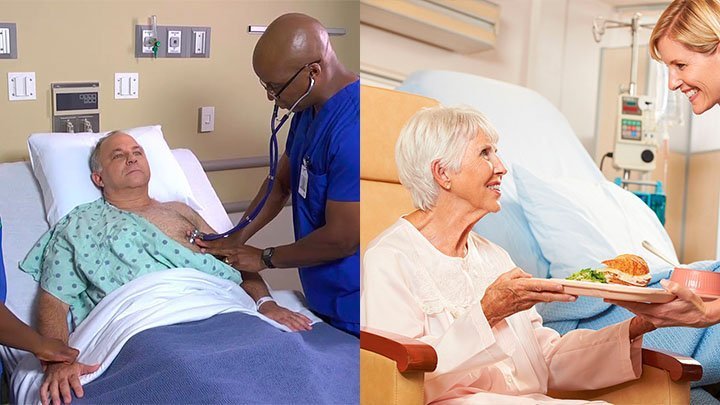As seniors age, they often face physical and cognitive changes that can make dressing a daily challenge. Dressing assistance can provide significant support, helping seniors maintain their dignity, independence, and well-being. In this blog post, Dieset Home Care Services helps explore the various ways dressing assistance benefits seniors, from improving their quality of life to ensuring their safety and health.
Maintaining Dignity and Independence

One of the primary benefits of dressing assistance is that it helps seniors maintain their dignity. Dressing oneself is a highly personal and private task that can become difficult as physical and cognitive abilities change with age. The act of choosing clothing and dressing oneself reflects an individual’s sense of identity and control over their lives. When caregivers assist seniors with dressing in a respectful and compassionate manner, it fosters a sense of self-worth and dignity, preserving the senior’s identity and autonomy.
Moreover, dressing assistance can help seniors remain as independent as possible. A caregiver’s support can be adapted to the senior’s specific needs—whether providing full dressing assistance or partial help, such as zipping up a jacket or fastening buttons. By enabling seniors to participate actively in the dressing process, caregivers can contribute to their self-confidence and reduce the feelings of dependence that many older adults experience.
Maintaining dignity and independence is essential for individuals, especially the elderly or those with disabilities. Dressing assistance services offer support while preserving personal autonomy, allowing individuals to choose their attire and express their style. This balance fosters confidence and self-esteem, enabling them to navigate daily life with grace. By providing tailored assistance, these services empower individuals to maintain their independence while ensuring their dignity remains intact, enhancing their overall quality of life.
Enhancing Safety and Reducing Injury Risks
Aging adults may struggle with various physical challenges that can make dressing a risky activity. For seniors with limited mobility or balance issues, reaching, bending, or standing for extended periods can increase the risk of falls or injuries. Dressing assistance ensures that seniors are protected from the physical strains and potential hazards associated with dressing. Caregivers can prevent injuries by helping with difficult tasks such as lifting arms for shirts or bending to put on shoes, making the dressing experience safer and less physically taxing.
Furthermore, dressing assistance helps reduce the risk of other health concerns, such as strained muscles, joint injuries, or skin damage caused by improperly fitted clothing. Caregivers can ensure that clothing fits correctly and comfortably, reducing friction on the skin and promoting better circulation. This preventive approach to dressing assistance helps seniors avoid injuries that could impact their long-term mobility and quality of life.
Promoting Physical Comfort and Health
Another significant benefit of dressing assistance is that it supports physical comfort and health. Seniors may face conditions such as arthritis, osteoporosis, or muscle weakness, making it difficult to manage clothing independently. Caregivers trained in dressing assistance can choose and adjust clothing to accommodate these physical limitations, prioritizing comfort and ease of movement. For example, adaptive clothing designed for seniors can simplify dressing with features like Velcro closures instead of buttons or zippers, reducing physical strain.
In addition to ensuring comfort, dressing assistance can improve seniors’ health by promoting hygiene. Properly fitted and regularly changed clothing prevents skin irritation and infections, which are especially common in seniors with limited mobility. Caregivers can also help seniors dress according to weather conditions, preventing exposure to extreme temperatures that can lead to health issues, such as hypothermia in colder climates or overheating in warmer conditions. By providing appropriate clothing for the weather and ensuring frequent changes, caregivers play a crucial role in the senior’s overall health and well-being.
Promoting physical comfort and health is essential for overall well-being. This includes creating a supportive living environment, maintaining cleanliness, and ensuring that essential daily tasks are manageable. Regular home care services can help achieve this by providing assistance with personal hygiene, meal preparation, and medication management. By fostering a comfortable home atmosphere, individuals can enhance their quality of life, encouraging both physical and mental health improvements.
Supporting Cognitive Function and Mental Health
Dressing can be an overwhelming task for seniors with cognitive impairments such as Alzheimer’s disease or other forms of dementia. The process of selecting appropriate clothing and coordinating different pieces requires cognitive skills that may be compromised in these individuals. Dressing assistance helps seniors with cognitive challenges by breaking down the task into smaller, manageable steps. Caregivers often use simple instructions and a calm demeanor to guide seniors through each part of the dressing process, reducing confusion and frustration.
Dressing assistance also provides a structure to the senior’s daily routine, which is particularly beneficial for individuals with dementia who thrive on consistency and predictability. A structured dressing routine can reduce anxiety, foster a sense of normalcy, and improve mood. Moreover, feeling well-dressed and put together can contribute positively to a senior’s self-esteem, helping them feel more engaged and connected to their surroundings. By assisting seniors with dressing, caregivers help alleviate cognitive challenges, contributing to a better mental state and enhanced cognitive function.
Building a Sense of Social Connection and Belonging
Social interaction and a sense of belonging are important aspects of overall well-being, particularly for seniors who may feel isolated or disconnected. Dressing assistance provides seniors with valuable human interaction that fosters companionship and emotional support. The simple act of helping someone dress involves communication, physical closeness, and an exchange of trust, allowing the senior to feel cared for and valued. This daily interaction can have a significant impact on a senior’s mental and emotional health, reducing feelings of loneliness and isolation.
Moreover, when seniors are dressed appropriately and feel presentable, they are more likely to engage in social activities and outings. Proper attire can instill confidence, encouraging seniors to participate in family gatherings, community events, or other social opportunities. Dressing assistance, therefore, supports social engagement and helps seniors maintain their social networks, which is essential for emotional resilience and overall life satisfaction.
Facilitating Personal Expression and Self-Identity
Clothing is an expression of individuality, style, and personal preferences. For seniors, maintaining their unique sense of style can be a way to hold on to their identity and self-worth. Dressing assistance helps seniors make choices about what they wear, allowing them to maintain control over their personal expression. By encouraging seniors to select their clothing and respecting their preferences, caregivers help preserve their individuality.
This approach to dressing assistance can be particularly beneficial for seniors who feel that they have lost control over many aspects of their lives due to aging or illness. Allowing them to choose their clothing and supporting their personal style empowers them to express themselves authentically. This empowerment fosters a positive self-image and reinforces their sense of identity, which is essential for mental and emotional well-being.
Reducing Caregiver Stress and Enhancing Family Dynamics
Family caregivers often face numerous demands and may feel overwhelmed by the physical and emotional challenges of caring for a senior loved one. Dressing assistance from professional caregivers can alleviate some of the burden on family members, reducing stress and enabling them to focus on other important caregiving tasks. When family caregivers are less stressed, they can approach caregiving with greater patience and compassion, improving the quality of their relationship with the senior.
Moreover, by involving professional caregivers in tasks like dressing, family members can enjoy quality time with their loved ones without the pressure of providing constant physical support. This balance helps maintain healthy family dynamics, promoting a positive and supportive environment for both the senior and their loved ones. Dressing assistance is thus beneficial not only to the senior but also to their family, fostering a harmonious and cooperative caregiving relationship.
Reducing caregiver stress is essential for maintaining healthy family dynamics. Strategies such as setting clear boundaries, seeking support from professionals, and engaging in regular self-care can help caregivers manage their responsibilities more effectively. Implementing a 24-hour supervision service can significantly alleviate the burden on family members, ensuring that loved ones receive constant care and attention. This support not only enhances the well-being of the caregiver but also fosters a more harmonious family environment.
Encouraging Physical Activity and Range of Motion
Dressing assistance can also serve as a form of gentle physical activity for seniors. Engaging in the dressing process, even with support, encourages movement and stretches muscles and joints, promoting better range of motion. For seniors with arthritis or joint pain, small exercises during dressing can help improve flexibility and reduce stiffness. Caregivers can incorporate light exercises and stretching routines into the dressing process, which helps seniors maintain mobility and reduces the risk of muscular atrophy.
By encouraging participation in the dressing process, caregivers promote a proactive approach to physical health, helping seniors stay physically active in a safe and controlled environment. This form of mild activity can contribute to improved circulation, better muscle tone, and a greater sense of physical well-being, all of which are important for a senior’s overall health.
Ensuring Consistency and Routine
Consistency and routine are essential for seniors, particularly those with cognitive impairments. Dressing assistance establishes a structured routine that provides a sense of stability and predictability. For seniors with memory issues, maintaining a regular dressing routine can help them feel grounded, even if other parts of their lives seem uncertain or confusing. Caregivers play a vital role in establishing and maintaining this consistency, allowing seniors to feel secure and in control.
This routine also serves as an anchor for other daily activities, helping seniors structure their day around familiar tasks. A consistent dressing routine reduces stress and anxiety, enabling seniors to approach their day with confidence and clarity. By providing dressing assistance, caregivers offer both practical support and emotional stability, which are essential for seniors’ overall quality of life.
FAQs
What are the benefits of dressing appropriately?
Clothes have a powerful impact on how we perceive ourselves and how others perceive us. Dressing well can boost your confidence, open new doors, and command rooms, and help you overcome imposter syndrome.
What is the main purpose of dressing?
The main purpose of wound dressing is: a) provide a temporary protective physical barrier, b) absorb wound drainage, and c) provide the moisture necessary to optimize re-epithelialization. The choice of dressing depends on the anatomical and pathophysiological characteristics of the wound.
What are the advantages of dressings?
Wound dressings can be used to limit tissue inflammation, prevent microbial overgrowth, prevent tissue infections, and control wound site exudate. Further, some dressings contain materials that stimulate the re-epithelialization phase of wound healing, resulting in a faster recovery rate in treated patients.
What is the importance of daily dressing?
Daily dressing changes also ensure that the wound is assessed every day for signs or symptoms of abnormal healing, the formation of necrotic tissues, and the presence of wound critical colonization or infection. Further, wound infections are not rare — up to 50% of acute wounds become infected.
What are the benefits of dressing properly?
Dressing well can positively affect our first impression on others, increase our self-confidence, lead to success in our professional lives, build relationships and mental health overall. It is a powerful tool and we should not take it for granted.
Conclusion: A Vital Aspect of Holistic Senior Care
Dressing assistance is much more than a routine caregiving task; it is a compassionate service that addresses the holistic needs of seniors. From ensuring safety and physical comfort to supporting emotional well-being and self-expression, dressing assistance plays a vital role in the lives of seniors. By providing support in a respectful and individualized manner, caregivers enable seniors to maintain their dignity, independence, and health.
The benefits of dressing assistance extend beyond the immediate act of dressing; they enhance overall quality of life, foster a sense of identity, and encourage social and physical engagement. As a crucial part of senior care, dressing assistance empowers seniors to live with confidence, security, and fulfillment, making it an invaluable service in the pursuit of their well-being.
